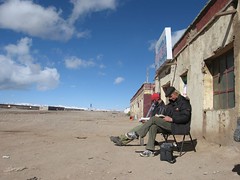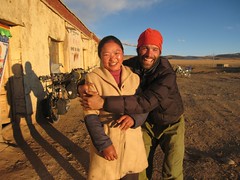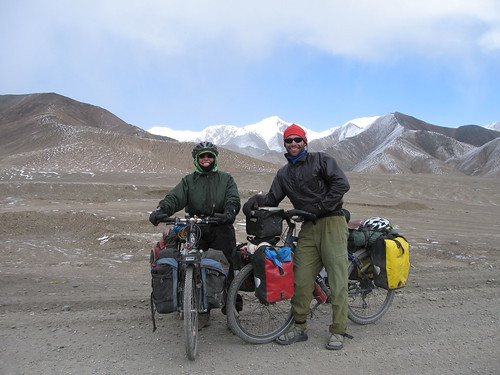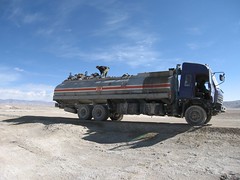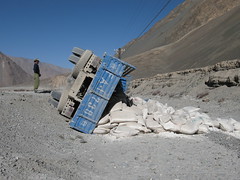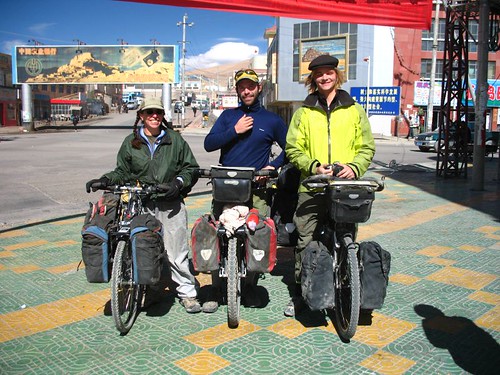Saga of Saga
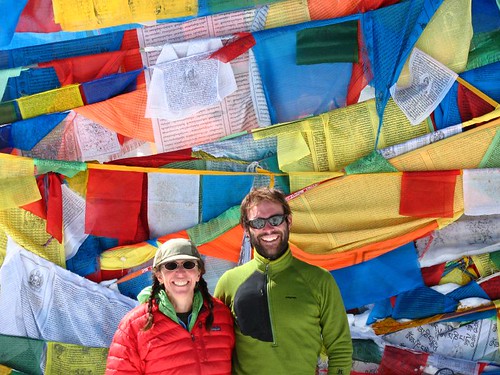
Happy Halloween. The five French Canadians in the hotel are ready with costumes, but I might miss my favorite holiday since there are two competing interests this evening: having my first shower and shampoo in two weeks when the hot water comes on between 7 and 10 pm; or sleeping before cycling tomorrow morning to help me make it the 60 or more kilometers it might take to reach an indoor sleeping site. Because I didn't sleep much last night, crammed in the back row of a stinky short bus with four other travelers riding with 15 other Chinese citizens, most of whom smoked through the night, "resting" against the ice-encrusted window, trying to keep from freezing beneath a PRC army coat. But at least we arrived in one piece this morning, scraped the centimeter of dust off the bikes and settled into a fairly snazzy $15 hotel room with hot water for three hours each night.
The past two weeks have been full of ups and downs. I wrote little more than a list of topics to cover, because for some reason, Tibet muzzles its pilgrims. So here are a few of the thoughts that reverberated through my troubled mind during the past fortnight.
Frying and Freezing
The thing you notice when you travel east in October on the Tibetan Plateau is My Left Foot. That's the one that perpetually rides in the shadow of the front panniers and never wants to warm up during the day. The right foot is quite comfortable, full sunshine penetrating the worn canvas of the the old summer hiking boots. In fact, the sun innudates all parts on the right side, as that is the direction of south. You can't really say that it all evens out- the right ear, the right cheek, withering and burning if you don't continually reapply sunscreen. Part of the challenge of the road.
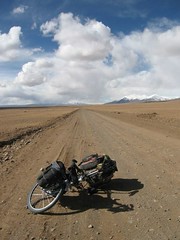
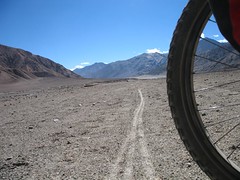
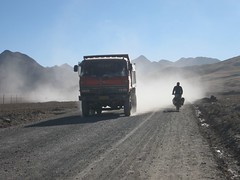
If It's Not
If it's not the cold, it's the headwinds. If it's not the headwinds, it's the dust. If it's not the dust, it's the sand. If it's not the sand, it's the gravel. If it's not the gravel, it's the washboard. If it's not the washboard, it's the gradient. If it's not the gradient, it's the altitude. If it's not the altitude, it's the cold... That's on the road.
In the tent. If it's not the smelly feet, it's the stinky gas. If it's not the gas, it's the B.O. If it's not the B.O. it's the garlic breath. If it's not the breath, it's the feet. Part of the acceptance of the trip.
Dogs, Doo-Doo, Human Excrement and Garbage: This is Tibet?
It has been hard to come to terms with what we see every day here. Disillusionment with some mythical anticipation of what Tibet would be. Prayers wheels, stupas, gompas, bells and colors on women's thick woolen garments, sweeping skyscapes. Yes, those things are to be seen. But more impressive, albeit in a very negative way, is the refuse everyhwere and the lack of concern of those who deposit it.
I'd heard of the vicious dogs present in Tibet. Well, canines are abundant, especially around the ubiquitous garbage heaps that punctuate every village road and path, but even the feeblest three year old is adept at tossing stones which these pups abruptly heed. Even waving your arm or growling at them causes thes four-legged creatures to take their tails away with them. Of course their doo doo remains. But this is of little consequence. When walking in the open- and here it is mostly open- you quickly learn to train your eyes and plot your path carefully. Yak and sheep and the occasional goat turd is not the least bit of a nuisance, especially as it often warms your sleeping room in a sweet-smelling heat stove fire. So avoiding the dogs' waste is second nature. And when nature calls, they tend to move off to an untrod place. Not so, the humans. Inexplicably, the local poplulation finds it appropriate to stop and squat in any and every place. And if they do decide to use the constructed facilities, they leave their deposits anywhere near or about the intended hole, making it nearly impossible to find safe footing to correctly aim yourself. If you dare enter these public facilities. And so you likely also head out to anyplace you dare to do your business. Feeling more animal and criminal than human and wondering how people can be so casual and unashamed.
Ali Full of Cyclists
That is the heading that Rich, the green card carrying Slovakian encaptioned a recent photo on his fantastic website (drogpatravel.blogspot.com) of several late season riders on the 219, as the Xinjiang-Tibet Highway is labeled, whom we first met him in Gilgit, Pakistan, at the end of our time there. In addition to Rich, nearing the end of his 6-month circa Himalya solo sojourn, is Nikolai the Dane who befell an unfortunate fate when he fell, alone before the crest of a 5160 meter pass and seriously injured his right hand. A sleepless, freezing and scary night sent him hitching to Ali where we met him for the first time, a few days later. He'd already heard of us from John, the kitchen-sink carrying Bostonian who combines hitching and cycling in a generous way. He makes Americano coffee and shares his oreos with good humor and kindness. He rolled into Ali on the bus which he'd flagged down en route, black-faced with diesel soot and cigarette smoke. And then there were the unstoppable French, Delphie and Ivan, who start riding at first light each day, and only stop for breakfast when the sun has climbed to a warming height in the sky- just about when Chris and I would be eating in the tent. It was great camraderie to meet with others at the winter-end of the Tibet season. And for the past two weeks we have been leap-frogging and reconnecting as we ride at our different paces or sometimes hitch to the same places.
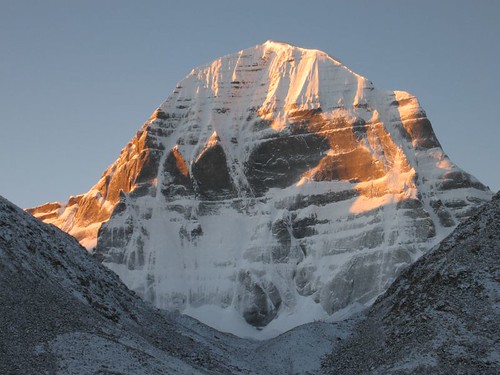
Clearly the high point, both literally (5660 meters) and figuratively, the walk around this holy and significant peak. It is near the headwaters of four of Asia's most important rivers. And Tibetans believe that circling this massif brings blessings proportional to the number of circuits. For me, it was a beautiful a nd quiet time in the clear air, surrounded by colored flags which create prayers as they flutter in the wind.
From Darchen to Saga
About 500 kilometers. 10 days riding or maybe 2 hitching. After our trek around Kailash, we decided we would just ride east for one day, because there was a village (read warm (?), indoor beds with no need for tents or campstoves in the wind) just 42 kms. away. After that, we would hitch to Saga where villages would then be spaced just a day's ride apart. It's not that we don't like sleeping on our inflatable Thermarest mattresses and eating instant noodles three times a day. Well, maybe we don't love that stuff. But our tent zippers are failing and the stove is very tempermental and the winds are wicked cold and the scenery, while beautiful, varies only slowly. And more importantly, the very few villages we passed through were mostly run-down, small, and not the best place to meet new people or make local friends. Better get going and get to a more southern locale. So we set out for our one day of riding. Less than a kilometer on the bumpy morning road, and a dump truck came by. Chris made an instant decision and within an hour we bounced into Hor Chu, having collected the Dane on the way, who got about 8 kilometers out of Darchen. We spent the rest of the day hitching, which is how we realized it was very unlikely anyone would pick us up. That evening, at the Chinese restuarant which would be our home for the next 5 days (we slept in comfy beds in the "motel" in the back), our hosts told us a bus would come. It came the next day, going the wrong way, but we paid a deposit and waited til the day after tomorrow for it to get us. Well, it broke down somewhere on the way back, and it was only on the 5th day the we finally got to spend a jarring, freezing, sleepless night on the way to Saga.